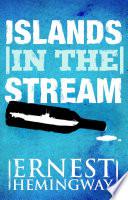
“But life is a cheap thing beside a man's work. The only thing is that you need it.”
Pt. 3: At Sea, Section 21
Islands in the Stream (1970)

Islands in the Stream is the first of the posthumously published works of Ernest Hemingway. The book was originally intended to revive Hemingway’s reputation after the negative reviews of Across the River and Into the Trees. He began writing it in 1950 and advanced greatly through 1951. The work, rough but seemingly finished, was found by Mary Hemingway among 332 works Hemingway left behind at his death. Islands in the Stream was meant to encompass three stories to illustrate different stages in the life of its main character, Thomas Hudson. The three different parts of the novel were originally to be titled "The Sea When Young", "The Sea When Absent" and "The Sea in Being". These titles were changed, however, into what are now its three acts: "Bimini", "Cuba", and "At Sea".
“But life is a cheap thing beside a man's work. The only thing is that you need it.”
Pt. 3: At Sea, Section 21
Islands in the Stream (1970)
“You never understand anybody that loves you.”
Pt. 3: At Sea, Section 21 (the last sentence of the novel)
Islands in the Stream (1970)
“Everybody is friends when things are bad enough.”
Pt. 3: At Sea, Section 17
Islands in the Stream (1970)
“Being against evil doesn't make you good. Tonight I was against it and then I was evil myself.”
Pt. 1: Bimini, Section 4
Islands in the Stream (1970)
Pt. 1: Bimini, Section 1 (the opening two paragraphs of the novel)
Islands in the Stream (1970)
Context: The house was built on the highest part of the narrow tongue of land between the harbor and the open sea. It had lasted through three hurricanes and it was built solid as a ship. It was shaded by tall coconut palms that were bent by the trade wind and on the ocean side you could walk out of the door and down the bluff across the white sand and into the Gulf Stream. The water of the Stream was usually a dark blue when you looked out at it when there was no wind. But when you walked out into it there was just the green light of the water over that floury white sand and you could see the shadow of any big fish a long time before he could ever come in close to the beach.
It was a safe and fine place to bathe in the day but it was no place to swim at night. At night the sharks came in close to the beach, hunting at the edge of the Stream, and from the upper porch of the house on quiet nights you could hear the splashing of the fish they hunted and if you went down to the beach you could see the phosphorescent wakes they made in the water. At night the sharks had no fear and everything else feared them. But in the day they stayed out away from the clear white sand and if they did come in you could see their shadows a long way away.